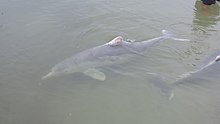Australian humpback dolphin
| Australian humpback dolphin | |
|---|---|
 |
|
| Australian humpback dolphins, Tin Can Bay, Queensland, Australia, 2016 | |
| Scientific classification | |
| Kingdom: | Animalia |
| Phylum: | Chordata |
| Class: | Mammalia |
| Order: | Artiodactyla |
| Infraorder: | Cetacea |
| Family: | Delphinidae |
| Genus: | Sousa |
| Species: | S. sahulensis |
| Binomial name | |
|
Sousa sahulensis Jefferson & Rosenbaum, 2014 |
|
The Australian humpback dolphin (Sousa sahulensis) is a species of humpback dolphin and the fourth recognized humpback dolphin species chronologically. The specific name sahulensis is derived from the Sahul Shelf, located between northern Australia and southern New Guinea, where the Australian humpback dolphins occur.
The species was scientifically described on 31 July 2014 in the journal Marine Mammal Science. As of August 2014, there is no population estimate for the Australian humpback dolphin, but based on available sighting data it is put to "a few thousand".
Australian humpback dolphins are slightly different from the other three humpback dolphin species in overall length, number of teeth, vertebrae and geographic distribution. The dorsal fin of the Australian humpback dolphin is lower and more wide-based than those of the Atlantic humpback dolphin and the Indian humpback dolphin, and its coloration is dark gray, while its closest humpback relative, the Chinese white dolphin, has distinctly white (often with a pink tinge) coloration. The Australian humpback dolphin also has a distinctive dark dorsal feature, resembling a cape.
Australian humpback dolphins have been observed strand-feeding. Humpback dolphins have been observed to display mating courtship between Australian snubfin dolphins.
...
Wikipedia
